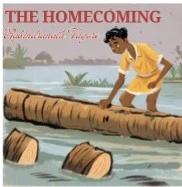About the Author
Rabindranath Tagore (1861-1941) was a renowned Bengali polymath who reshaped Bengali literature and music. Born into a prominent intellectual family in Calcutta, he started writing poetry at the age of eight. He became the first non-European to win the Nobel Prize in Literature in 1913 for his collection of poems “Gitanjali.” Tagore was not just a poet; he was a philosopher, musician, writer, playwright, composer, and painter. He wrote the national anthems of two countries – India (“Jana Gana Mana”) and Bangladesh (“Amar Sonar Bangla”). In 1921, he founded Visva-Bharati University in Santiniketan, which aimed to blend the best of Indian and Western traditions. His works include over 2,000 songs (known as Rabindra Sangeet), numerous short stories, novels, dramas, essays, and thousands of poems. Notable works like “Ghare Baire” (The Home and the World), “Gora,” and “Chokher Bali” address complex social issues. Tagore was also a strong critic of British colonialism and supported India’s independence movement, though he often disagreed with Gandhi’s methods. His progressive educational philosophy and artistic vision continue to influence Indian culture and global thought. He passed away in 1941, leaving behind a rich legacy of literature, art, and philosophical thought that continues to inspire generations.
Summary of the Story
Phatik is a playful 14-year-old boy who lives in a village with his mother and younger brother Makhan. After his father’s death, his mother raises the two boys alone. Phatik often teases his little brother and gets into trouble in the village.
One day, Phatik’s uncle visits from the big city, Calcutta. He sees that Phatik is quite naughty and offers to take him to the city. He thinks city schools will make Phatik a better boy. Phatik’s mother agrees, hoping her son will learn good behavior there.
But life becomes very hard for Phatik in the city. He can’t do well in his new school. His aunt (uncle’s wife) is always angry with him. His cousins make fun of him because he comes from a village. Phatik feels very lonely and misses his home, his mother, and even his brother whom he used to trouble.
Soon, Phatik becomes so sad that he falls sick. He gets high fever and keeps calling for his mother. When his mother finally comes to see him in the city, Phatik is very ill. Sadly, he dies soon after seeing his mother one last time.
This simple story shows us how important it is to understand what children really need. Sometimes, they need love and care more than a fancy education. It also tells us that forcing children to live away from their comfortable surroundings can hurt them deeply.
Characters in the Story
Main characters in and their roles in the story:
1. Phatik Chakraborti
– The 14-year-old protagonist
– Eldest son of a widow
– A mischievous, free-spirited village boy
– Known for his playful but sometimes bullying nature
– Struggles to adapt to city life and formal education
– Ultimately succumbs to illness brought on by emotional distress
2. Makhan
– Phatik’s younger brother
– Often the target of Phatik’s pranks and bullying
– Represents the more compliant, well-behaved child
– Stays with his mother in the village
3. Phatik’s Mother
– A widow raising two sons in the village
– Initially sends Phatik to Calcutta hoping for his better future
– Shows deep maternal concern despite Phatik’s troublesome behavior
– Rushes to Calcutta when she learns of his illness
– Represents unconditional maternal love
4. Maternal Uncle (Bishamber)
– Lives in Calcutta
– Offers to take Phatik to the city for better education
– Well-intentioned but fails to understand Phatik’s emotional needs
– Represents the urban educated class who believe city education is the only path to success
5. Aunt (Uncle’s Wife)
– A strict, unsympathetic character
– Constantly criticizes Phatik
– Fails to show any maternal affection towards him
– Treats him as a burden
– Represents the hostile urban environment that Phatik encounters
6. Phatik’s Cousins
– The uncle’s children
– Mock Phatik for his rural mannerisms
– Add to his sense of alienation in the city
Through these characters, Tagore creates a complex web of relationships that highlight various social dynamics: rural versus urban life, traditional versus modern education, and most importantly, the crucial role of understanding and affection in a child’s development. Each character serves to either deepen Phatik’s alienation or highlight what he has lost by leaving his village home.
The contrast between characters like the mother and the aunt, or between Phatik’s village friends and his city cousins, helps emphasize the story’s themes of belonging, displacement, and the importance of emotional nurturing in a child’s life.
Multiple Choice Questions
1. What was the wood log meant to be used for?
a) making a chair
b) making a mast for a boat
c) repairing a boat
d) making toys
2. Who tried to stop the moving of the log?
a) Phatik’s mother
b) Phatik’s friends
c) Phatik’s brother
d) Phatik’s uncle
3. What did Phatik decide to do with his brother?
a) push him along with the log
b) pull him away
c) let him sit on the log
d) complain to their mother
4. Who come to visit Phatik's mother?
a) their grandfather
b) their uncle
c) their aunt
d) cousin
5. What was Phatik's reaction to the uncle's offer to take him to Calcutta?
a) happy and eager
b) sad
c) scared
d) nervous
6. What did Phatik leave for his brother?
a) bicycle
b) wooden log
c) books
d) fishing-rod, kite and marbles
7. What was the aunt's reaction to Phatik living with the family?
a) overjoyed
b) annoyed and angry
c) welcoming
d) sad
8. What did Phatik lose?
a) school textbook
b) fishing rod
c) marbles
d) shoes
9. How did Phatik become ill?
a) ate bad food
b) walked home ub the rain with a fever
c) malaria
d) seasonal flu
10. What was Phatik's deepest desire?
a) to belong and be loved
b) to be a ringleader
c) to be a boatsman
d) to become a teacher
11. What was the original Bengali title of "The Homecoming"?
a) Ghare Baire
b) Chhuti
c) Gora
d) Gitanjali
12. How old was Phatik Chakraborti in the story?
a) 10 years
b) 12 years
c) 14 years
d) 16 years
13. Where did Phatik's uncle live?
a) Delhi
b) Mumbai
c) Calcutta
d) Chennai
14. In which year did Rabindranath Tagore win the Nobel Prize in Literature?
a) 1911
b) 1912
c) 1913
d) 1914
15. What was the name of Phatik's younger brother?
a) Makhan
b) Bishamber
c) Ratan
d) Nikhil
16. What institution did Tagore establish in 1921?
a) Calcutta University
b) Visva-Bharati University
c) Delhi University
d) Presidency College
17. What was the primary reason for sending Phatik to Calcutta?
a) For medical treatment
b) For better education
c) To earn money
d) To learn music
18. How did Phatik die?
a) In an accident
b) By drowning
c) From fever and illness
d) From injuries
19. At what age did Tagore start writing poetry?
a) Six years
b) Seven years
c) Eight years
d) Ten years
20. Which of these works won Tagore the Nobel Prize?
a) Gora
b) Gitanjali
c) The Home and the World
d) Chokher Bali
Answer the following questions in One sentence
- Why did Makhan sit on the log?
- What did Phatik do with Makhan when he complained to their mother?
- What was the uncle’s generous offer?
- What led to Phatik’s desire to go back home?
- How was Phatik found in the morning?
Answer the questions briefly (30-40 words)
- Why did Phatik’s mother readily agree to the uncle’s offer?
- How did Phatik feel arriving at the uncle’s house?
- Why did he feel suffocated in the big city?
- Discuss the relationship between Phatik and the two women in the story.
References:
Board of editors Literary Mindscapes I. Macmillan Publishers India Pvt. Ltd. Chennai, 2021.


1 thought on “The Homecoming by Rabindranath Tagore”